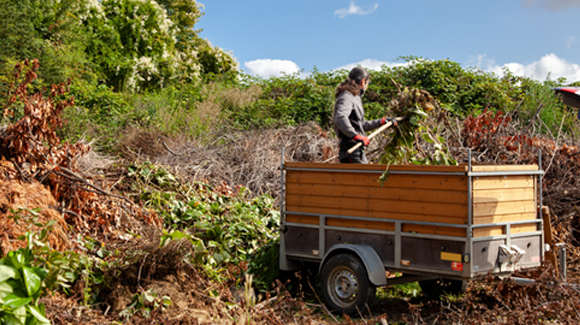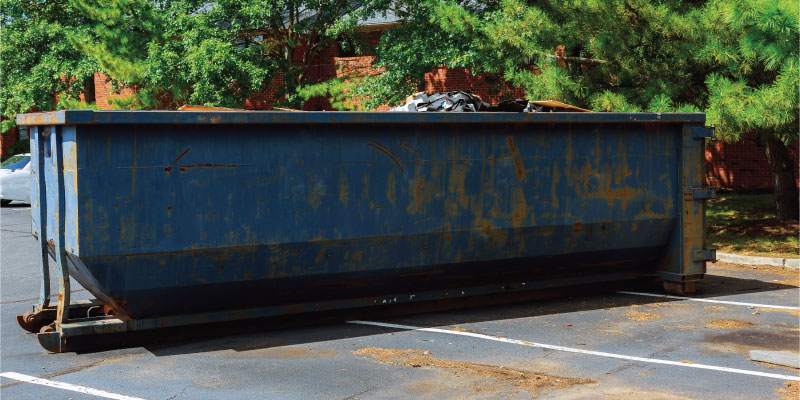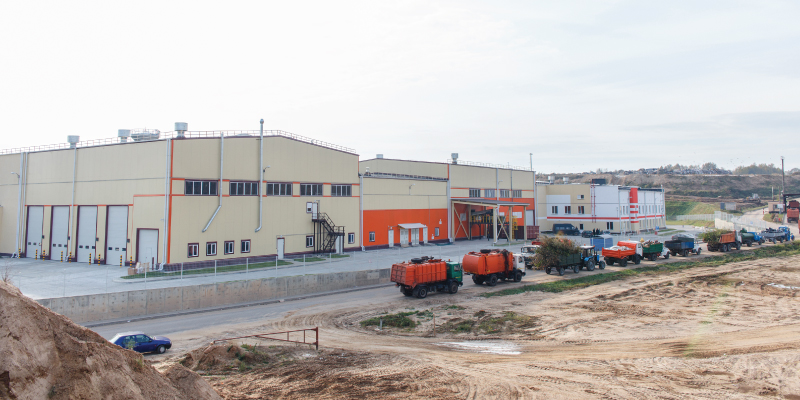
Updated March 15, 2024
Landfills play a crucial role in managing the waste generated by communities around the world. While recycling and waste reduction are essential components of a sustainable waste management strategy, landfills remain an integral part of the process, and utilizing a landfill can look a couple different ways.
Of course, tossing items in your curbside trash collection is one way to get your unwanted junk and trash to the landfill, but you can also rent a dumpster for larger loads or haul items there yourself using your own vehicle or trailer.
In this article, we will delve into the inner workings of a landfill and how they function, and explore the pros and cons of the different ways to drop off at a landfill.
Jump to:
- Understanding the Basics of Landfills
- What to Expect When Dropping off Waste
- Pros & Cons of Dropping off at a Landfill
- Pros & Cons of Renting a Dumpster
Find dumpster rentals near you
Understanding the Basics of Landfills
Most people understand that a landfill is a designated area where waste materials are deposited and buried. The goal is to contain and isolate the waste from the environment to prevent contamination and the spread of diseases.
Modern landfills are engineered facilities that incorporate advanced technologies to minimize environmental impact and promote safety.
Key Components of a Landfill
- Base Liner System: At the bottom of a landfill, there is a liner system consisting of impermeable layers such as clay and synthetic materials. This prevents leachate, a toxic liquid that forms when water passes through waste, from seeping into the surrounding soil and groundwater.
- Cell Construction: Landfills are divided into cells, which are specific areas designed to hold waste for a certain period. Once a cell is filled, it is covered with a protective layer of soil, and a new cell is opened.
- Leachate Collection and Treatment: To manage leachate, landfills are equipped with collection systems that gather the liquid. This leachate is then treated to remove contaminants before being safely discharged or reused.
- Gas Collection System: As organic waste decomposes, it produces gases, primarily methane. Landfills capture these gases to prevent their release into the atmosphere, reducing greenhouse gas emissions. Methane can also be harnessed as an energy source.
Keep reading:
- How Garbage Is Safely Contained in Landfills
- The Importance of Diverting Debris and Waste from Landfills
What to Expect When Dropping off Waste
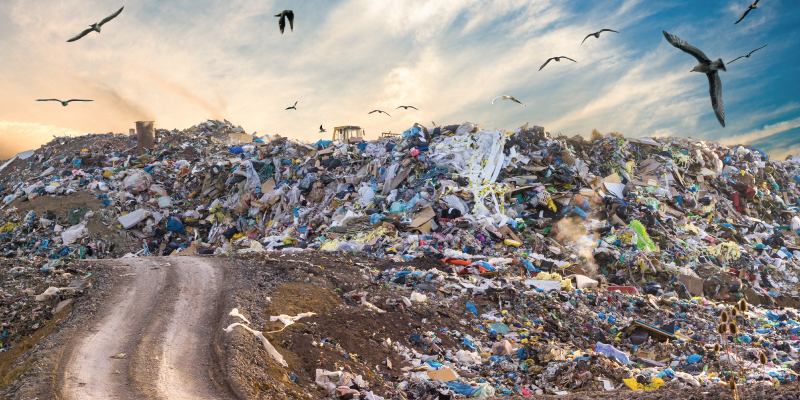
Dropping off a load at a local landfill involves several steps to ensure the proper disposal of waste is in compliance with environmental regulations.
The specific process may vary depending on the landfill and local regulations, but the following is a general overview of what typically happens when a resident wants to drop off a load at a local landfill:
Step 1: Arrival at the Landfill
When a resident arrives at the landfill, they will typically approach a designated entrance or checkpoint. It's essential to follow any posted signs and guidelines for entering the facility safely.
Step 2: Weighing and Registration
Many landfills have weighing scales at the entrance to determine the weight of the incoming waste. Vehicles, often trucks or trailers carrying the waste, are weighed before and after unloading. The difference in weight helps calculate the amount of waste being deposited. Some landfills may require residents to register or provide information about the type of waste they are disposing of.
Step 3: Separation of Materials
Landfills often have designated areas or bins for different types of waste, such as general household waste, recyclables, and hazardous materials. Residents may be directed to separate their waste accordingly. Some landfills encourage recycling by providing separate containers for recyclable materials.
Step 4: Payment of Fees
Landfills typically charge fees based on the weight or volume of the waste being deposited. After the waste is unloaded, residents will proceed to a payment station to settle the disposal fees. Fees may vary depending on the type of waste and local regulations.
Step 5: Safety Guidelines
Landfills have specific safety guidelines that residents must follow. These may include speed limits, designated traffic lanes, and instructions on how to safely unload waste. It's important for residents to adhere to these guidelines to ensure the safety of both themselves and landfill staff.
Step 6: Supervision and Assistance
Landfill staff may be present to supervise the unloading process and provide assistance if needed. They can guide residents to the appropriate disposal areas and answer any questions about the landfill's rules and regulations.
Step 7: Environmentally Conscious Disposal
Residents should be aware of any restrictions on certain materials and ensure that they dispose of waste in an environmentally responsible manner. Some landfills have specific areas for items like electronic waste, construction debris, or hazardous materials.
Step 8: Documentation and Receipts
After the waste is deposited and fees are paid, residents may receive documentation, such as a receipt or a record of the transaction. This documentation is important for tracking waste management activities and may be required for regulatory purposes.
Step 9: Recycling Opportunities
Some landfills actively promote recycling by providing facilities for separating recyclable materials. Residents should take advantage of these opportunities to reduce the amount of waste going to landfills and promote sustainable waste management practices.
Step 10: Exit and Compliance Checks
Upon completion of the disposal process, residents can exit the landfill. In some cases, there may be compliance checks to ensure that waste was deposited appropriately and that all fees were paid.
Learn more: Trash Disposal Showdown: Junk Removal vs 10 Yard Dumpsters vs Bag Dumpsters
Find dumpster rentals near me
Benefits and Advantages to Dropping off at a Landfill
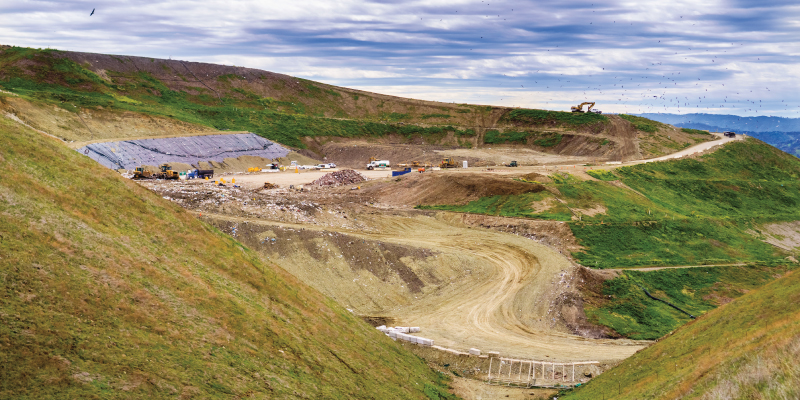
Let's take a closer look at the pros and cons of dropping off at a landfill yourself to get a better understanding of whether or not it's a good fit for you...
Pros of Dropping off at a Landfill
- Immediate Disposal: Dropping off waste at a landfill provides an immediate solution for getting rid of unwanted items without the need for coordinating a dumpster rental and waiting for pick-up.
- No Time Constraints: There is typically no time constraint when using a landfill. Residents can drop off waste at their convenience during the landfill's operating hours; they don't have to wait for dumpster drop-off.
- Cost Control: Residents only pay for the disposal of the specific load they bring to the landfill, which can be cost-effective for small to moderate amounts of waste.
Cons of Dropping off at a Landfill
- Limited Accessibility: Landfills may not be easily accessible for everyone, requiring transportation to and from the facility. This can be inconvenient, especially for those without suitable vehicles.
- Damage to Vehicle: Landfills are notorious for their uneven terrain. After all, you often have to drive up a mountain of compacted trash to reach the drop-off point. That mountain of trash can affect your vehicle's suspension and also contains sharp objects that can puncture a tire.
- Environmental Impact: While modern landfills are designed to minimize environmental impact, dropping off large amounts of waste still contributes to the overall environmental footprint.
Read more: How Much It Costs to Dump at the Landfill (and Why It's Not Always the Best Option)
Benefits and Advantages to Renting a Dumpster
Renting a dumpster can be a great—and often superior—alternative to dropping off at the landfill yourself.
Pros of Renting a Dumpster
- Convenience: Dumpster rentals offer the convenience of having a container delivered to the desired location, allowing for easy and on-site disposal without the need for multiple trips to a landfill.
- Flexible Timeframe: Renting a dumpster provides flexibility, allowing individuals or businesses to dispose of junk over a specified period, which is beneficial for larger clean-up projects.
- Cost Efficiency: For significant amounts of waste, renting a dumpster can be more cost-effective than paying individual fees at a landfill, especially when considering transportation costs.
Cons of Renting a Dumpster
- Time Constraints: Dumpster rentals often come with time constraints, and exceeding the agreed-upon rental period may result in additional charges.
- Permit Requirements: Some locations may require permits for placing a dumpster on private property, and obtaining these permits can add to the overall cost and administrative hassle.
- Limited Space: The size of the rented dumpster may limit the amount of waste that can be disposed of at once. For large-scale clean-up projects, a large dumpster or multiple small dumpster rentals may be necessary.
Understanding how landfills work and what to expect when dropping off waste equips individuals with the knowledge they need to make an informed choice about their disposal practices. Weigh the pros and cons of each drop-off method to be sure you're doing the best thing for you and your project. If renting a dumpster is your best option, let Hometown help you find a qualified local dumpster rental service. Read verified customer reviews, easily request multiple free quotes with the click of a button, and get answers to common dumpster rental questions—all in one place.

